OUR critical age, while it develops a new reverence
for the past, has worked havoc among time-honoured etymologies of
place-names. A letter stolen into Hebudes, the old form of Hebrides, makes
unstable base for derivation from a heathen goddess represented in
Christian mythology by St. Bridget or St. Bride, whose name turns up so
often in the Highlands. But from time immemorial these warring seas
clashed around island sanctuaries. Christianity here took over many
shrines of an older worship, and long sacred fires to burn on new altars,
with ministrants and vestal virgins bound by holier vows. In books like
Mr. Frazer's Golden Bough we learn what outworn superstitions still lurk
in disguise about the walls of manse and schoolhouse; how children having
the Shorter Catechism by heart may play all unsuspecting with relics of
heathendom; how their fathers, while banning the sign of the cross,
preserve in ugly obelisks the idols of pagan high places; and how the
festivals of forgotten Baals may still command maimed rites among those
who frown at Christmas or Good Friday as recalling Romish superstition.
Mourners who abhor a form of prayer at the grave will take a funeral out
of its way that it may follow the course of the sun after ancient custom.
There are sacred wells in the Highlands, long ago baptized by some
Christian saint, that have not wholly exhaled their ancient virtue in this
or that disorder, and, at least within a few years back, had yet their
votive offerings of pins or bits of rag. It is a question whether the
renowned Loch Maree gets its name from the Virgin Mary, or from a certain
saint, Mourie, alias Malruba, whose memory became so confounded with that
of a heathen bugbear that as late as Covenanting days the Presbytery was
scandalised to find bulls still sacrificed to this dubious evangelist.
Old books speak of the western islands as sacred, some of the smallest
among them appearing specially hallowed ground. How did successive
adorations come to be concentrated on the low, bare islet of Iona, lying a
mile off the farther point of that long promontory called the Ross of
Mull? From the dawn of legend it seems to wear a misty halo. Its oldest
name means the island ; in Gaelic it is the Isle of the Druids; then its
alias Icolmkill embalms the memory of St. Columba, who from this
beacon-fire lit the Gospel all over the Highlands. What task that was may
be guessed by the picnic pilgrims whose passage from Oban often turns out
so rough that not all of them are at ease to indulge Dr. Johnson's
elevated mood among such sacred ruins.
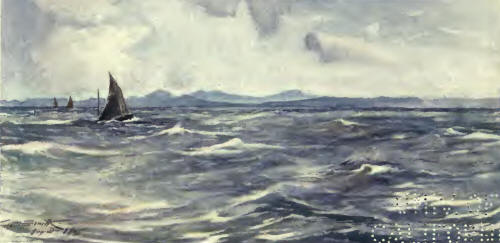
Palladius is said to have been the earliest missionary to Scotland. He was
closely followed by St. Ninian, whose light seems to have smouldered on
the savage shores of Galloway, till from his dying hand St. Patrick in the
fifth century carried it over to Ireland to blaze up before half of
Europe. From this school of piety and learning in the next century came
St. Columba, as penance for sin devoting himself to the conversion of the
wild Picts. The legend goes that he first disembarked on Oronsay, but
quitted it because thence he could still catch sight of his beloved
Ireland. Landing on Iona, he buried his boat lest he should be tempted to
return. But he had no sooner settled his little band in rough wattled
buildings than they were building other coracle craft of wicker-work
covered by skins, in which to launch forth on the perilous Hebridean seas
and up the long inlet of lake and glen that opens the heart of the
Highlands. In the second half of his busy life he pushed repeated journeys
to the far north, to the Orcades, even, it is said, as far as Iceland,
preaching through interpreters, founding mission stations, and planting
civilisation as well as faith among barbarous people. With the double text
laborare and orare, he taught his followers to make the best of that poor
soil of Iona, from which such pregnant seeds went forth on every wind. He
is said to have copied the Gospels three hundred times with his own hand.
This saint had his weaknesses, those of his creed and time. He would allow
no woman on Iona, nor even a cow, for "where there is a cow, there is a
woman; and where is a woman—" we know what monks thought of Eve's
daughters. An adjacent islet was given up to a nest of nuns who had
fluttered towards this cold halo. So great waxed the fame of Columba's
sanctity that pilgrims sought his retreat from all parts of Western
Christendom ; and a sore pilgrimage that must have been that ended at the
point of Mull, where a miraculously strengthened hail would bring over a
boat from the island. Still the saint's memory looms through a cloud of
miracle and fable, behind which we catch the human proportions and
qualities of a strong good man, who had such power of winning hearts.

It is possible that his part in the conversion of Scotland has been
exaggerated. In his lifetime St. Kentigern was at work among the Cumbrian
Britons, and the two evangelists are said to have met at Glasgow. About
the time of his death landed in Kent those Roman missionaries who were
long on such dissenting terms with the native church that the Anglian
saint Guthlac, after spending a night of terror, beleaguered as he
believed by Welsh Christians, gave thanks in the morning to find how the
assailants of his hermitage had been no worse than devils. The Culdees,
whom Presbyterians have claimed as spiritual forefathers free from Popish
error, are taken for disciples of St. Columba, though some Roman writers
go about to invest them with Augustinian orthodoxy. Into heathen
Northumbria also went his missionaries, to encounter those of Rome over a
great part of England; and on the east coast the Holy Isle of Lindisfarne
grew to be another Iona.
While Scotland went on being dotted with the Culdee chapels and
monasteries, Iona became a Christian Mecca, as well as a centre of
education and missions. The bodies of princes and chiefs were brought here
to be buried in sacred ground, as Persians to-day undertake long perilous
pilgrimages to lay the bones of their dead beside those of Hussein or of
Imam Reeza, whose tombs, as Iona was, are still sanctuaries of refuge from
human justice or revenge. Sixty kings of Scotland, Ireland, and Norway
have been counted as buried in this little isle, some of them perhaps
since before Columba's time. Duncan and Macbeth are fabled to lie here
side by side; yet when we come to more authentic kings, this royal
sepulchre seems no longer in reverence, for even Alexander II., who died
conveniently on the island of Kerrera, was carried for burial all the way
to Melrose.
There can be no more impressive sight than the burial-ground with its
sculptured stones and worn1 crosses that mark now the undistinguished dust
of men who at least "did not expect to be so soon forgotten." By the
twelfth century Cluniac monks had taken the place of the original
garrison, more than once broken up by raids of Norse pirates. The oldest
building is St. Oran's Chapel, believed to have been erected by the pious
Margaret, Malcolm Canmore's English queen, who built also the chapel in
Edinburgh Castle. The Nunnery appears to be later work, and the Cathedral
to date from the thirteenth to the sixteenth century. These memorials,
hastily visited by drenched and sea-sick tourists, make but fragments of
the ecclesiastical state that once flourished on Iona. Its monuments came
to be rudely treated at the Reformation, when all but two of 360 crosses
are understood to have been thrown into the sea by an iconoclastic
Presbytery, unless some of them had been transported to the mainland, as
perhaps was that fine one preserved at Campbeltown. The memorial chapels
seen by Dean Munro at the end of that century have since disappeared. The
high altar of white marble still stood at the time of Pennant's visit.
About 1830 vanished obscurely the last of the black stones on which
Highlanders of old swore their most binding oaths, perhaps the oldest of
all lona's relics, once as sacred as the corner-stone of the Kaâba. So
late as the English reign of James I., at the prompting of that pacific
king, two clans met here to make a solemn covenant of peace after
centuries of bloodshed. Now the Cathedral, given up by the late Duke of
Argyll to the Church of Scotland, is being restored ; and the choir has
been already turned into a place of Presbyterian worship for its small
congregation. The marble quarries of the island, one hears, are again to
be exploited for the adornment of other churches.

Nine miles to the north of Iona lies Staffa, whose columned caves can
hardly have escaped serving as pagan fanes-
trembling reflecting lights, which trickle and waver over every hidden
crevice of roof, or clustered columns. Quick as thunder-roar follows the
lightning-flash is that white gleam succeeded by a booming sound, louder
than the thunder itself, yet mellow as the sweetest note of some huge
organ, and wakening echoes deeper and more sonorous than ever throbbed
through dim cathedral aisles ;—echoes which linger and repeat themselves
on every side, and are but hushed for one moment of awful silence while
the exquisite green water recedes, only to rush back again with renewed
force, re-awakening that thrillingly-solemn chorus, which, in ages long
gone, earned for this cave its old Gaelic name of Uaimh Bhinn, "the
melodious cavern." Altogether it is a scene of which no words can convey
the smallest idea, and as we pass suddenly from the glaring sunlight into
that cool deep shade, and look down into the wondrous depths of that world
of clear crystalline green, we cannot choose but believe that we have
invaded the chosen home of some pure spirit of the sea—some dainty Undine,
whose low musical notes we can almost think we discern, mingling with the
voice of the waves.
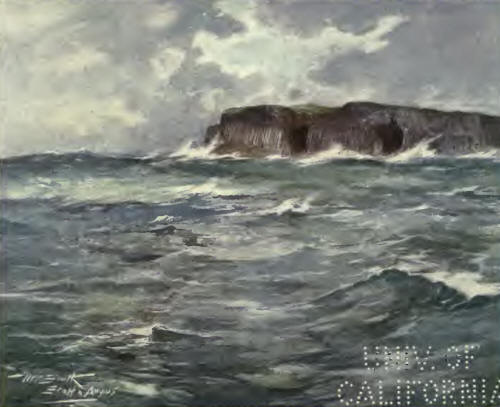
Johnson did not take the trouble to turn aside to Staffà, which had been
brought to notice about that time by Sir Joseph Banks ; and there is
reason for belief that the title "Fingal's Cave" was imposed by this
savant. But indeed the Doctor had passed unwittingly near other marvels of
columnar basaltic formation, such as are found in many parts of the
Hebrides, sometimes on a more enormous scale, if not so regularly finished
as at Staffa. MacCulloch, who says much the same of Ulva, declares that
had Staffa remained unknown, the caverned promontory of Duin, near Duntuim
at the north-east corner of Skye, would have won like celebrity. Then all
round the eastern side of this headland the same formation is continued,
where Loch Staffin's name proclaims its relationship with that "Isle of
Columns," and the "Kilt Rock" takes its title from a chequered display of
many- coloured strata crossed by lines of grass, bearing up monstrous
plaits and stripes of stone, red, brown, and yellow. The Shiant Isles
between Skye and Lewis show another grand columnar façade rising out of
the sea. The island of Eigg abounds in small ranges of basalt more or less
exposed, all overshadowed by the mile-long organ-face of its Scuir, that
at one point towers to a height of about 1300 feet, a more gigantic
Giant's Causeway piled up in tiers to the clouds, till often its head
seems to hang in air, like an enchanted castle beleaguered at its base by
glooms and mists, whirling forth from the fearsome peaks of Rum.
Skye has as many memories of Columba as if here had been the home of a
saint whose name has been associated with more West Highland chapels and
caves than there are modern churches in that wide diocese of his. Near
Iona, Colonsay is named after him, as Oronsay from his companion Oran, the
ruins of a monastery still visible on the latter, and the abbey on the
former not yet forgotten. But one cannot enumerate all the remains of
ancient piety scattered over the Hebrides, in most cases ill accessible to
hasty curiosity. The chances of reaching and in rough weather of landing
on those islands give consideration how cut off from the world they were
before the days of Watt and Macadam, and under what difficulties the
sturdy apostles carried on their work. Some out-of-the-way islands may
still have to go without ordinances of the Church for months or years
together. Some islets are garrisoned by a single family, or by the crew of
a lighthouse, who in one case were swept away together by the cruel
Atlantic waves, an accident proclaimed by the dying out of their lantern.
There are parishes like that of the "Small Isles," where the minister has
to be sailor as well as divine ; yet often his boat must turn back in
sight of an expectant congregation. On the mainland, too, inlets and
swollen rivers may make getting to church no matter of course. Norman
Macleod tells of Morven, where his grandfather's stipend began at /o a
year, that it contained 2000 souls scattered over 130 square miles with a
seaboard of 100 miles, and not a road in the parish. I have known cases
where people walked a dozen miles or so to church I have had farther to go
myself, but that was to a "chapel," attendance at which, one fears, made
excuse for a Sabbath drive. It is no wonder if Highlanders are found a
little behindhand in theological fashions, while zealous for the faith as
they understand it to have been once delivered to Presbyterian saints.
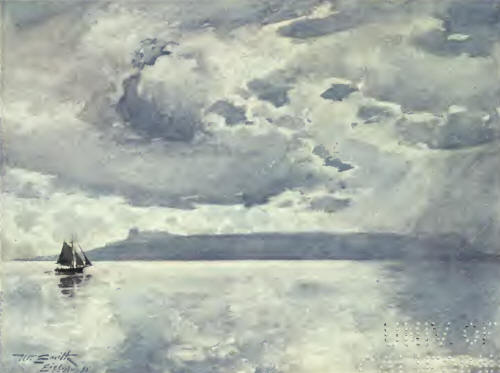
Even in sight of Oban hotels one may still find them so near and yet so
far. I once spent some time on the green island of Lismore, "the great
garden," that lies as one of the breakwaters of that smart tourist- haven.
Not so much of a garden now, this island was an old seat of the Argyll
Bishops. The Book of the Dean of Lismore is a famous sixteenth-century
collection of Gaelic poems. Later on, the Presbyterian minister of the
island had a grandson who became Lord Macaulay. Forty years ago its only
mansion preserved what had been for a time the Catholic College now
flourishing on the Dee, its Refectory, fitly enough, being used as a
dining-room, while the chapel was desecrated by division into a
smoking-room and a carpenter's shop. The then owner was a lady who without
scandal may be called peculiar. Though herself from the Lowlands, if I am
not mistaken, her whim was to play the Highland chieftainess of the good
old time. The tenants were encouraged to bring cases before her for
decision, Donald's hen scratching in Duncan's garden, or such like; and as
the judgment, along with a mild admonition to the offender, usually
included a bottle of whisky presented to each party, there was no lack of
recourse to her amateur jurisdiction. As became her state, she kept a
barge in which to go shopping at Oban, but the crew were always hard to
get together, still more so from the whisky shops of the town. One day, on
the way back, a midshipman of our party took upon himself to steer and
give orders in such a quarter-deck tone that the offended Highlanders
mutinied by lighting their pipes, folding their arms, and sullenly letting
us drift about a long afternoon at the will of the currents, till either
Celtic pride relented or some touch of Caledonian prudence counselled
keeping us all out of mischief, when the presuming youth had humbled
himself so far as to own that it takes local experience to navigate those
waters. The distance across in a straight line may be some half-dozen
miles, and the alternative way to Oban was by walking or driving a score
of miles and passing three arms of the sea.
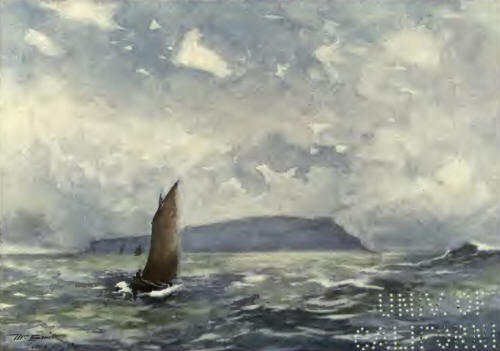
The only other house of anything like gentility on the island was the
minister's, who took in dipsomaniacs to board, shut off from temptation by
rushing tides. My fellow-guests were, all but one, lads of my own age, who
in this social solitude had a grand time of it, fishing, swimming, and
crawling over rocks to stalk shy seals that basked oil outer side of the
island, cheerfully drenched and tanned by turns, like ourselves. Our
hostess we hardly saw, as one of her peculiarities was being invisible all
day, and haunting the house by night. It may seem ungracious to tell such
tales of a too hospitable lady, dead many a day, but the fact is that I do
not remember even her name, which I never heard till she haled me, almost
by force, to her fortress, whence it was quite an adventure to get away. I
had to bribe all servant, another remarkable "character," who played the
part of masterful factotum in this domain. With his connivance I was to
slip out at 2 A.M., to be driven to the farther end of the island, and
there by boat to waylay a steamer on its zigzag course from the Outer
Isles. At the moment of escape, to my confusion, the chátelaine turned up,
who did not try to detain me, but insisted oil my companion, and caused
such delay by her vagaries that I nearly missed the steamer, then much
offended the Highland boatmen by too peremptorily bidding them haste, as
if I were a chief of Ulva's Isle with Lord Ullin's daughter on board
instead of an eccentric widow lady. That strange imprisonment on Lismore
would have been a more irksome experience later in life; yet I have often
thought what a chance of making "copy" was there lost to a writer of
books.
What travel among those broken shores was before steamboats—the boarding
of which from pierless islands may still be adventurous—we may guess from
David Balfour's troubled wanderings, from the delays of Dr. Johnson's
difficult tour, and from the fact that when old Dr. Macleod went to
college at Glasgow the journey from Morven by land and water took ten
days. Inns also are still few and simple in such poorly peopled wilds,
where to guard the distressful Celt against a besetting sin his lords have
sometimes enacted a private prohibition of liquor law. Nor has this
stretch of the southern Hebrides much to tempt the general tourist from
his lines of more luxurious travel. Some points well deserve an hotel and
guide-book notice, such as the grand quartzite masses of the Paps of Jura,
commanding a view from Skye to the Isle of Man; and the map of islets and
inlets spread out, weather permitting, below the triple-crested Ben More
of Mull, whose little white capital Tobermory has been compared to a damp
Naples in respect of looking its best from the sea. Professor Blackie,
with his sanguine optimism, proclaimed Mull "the most beautiful of the
western isles"; but that is not a generally received tenet. Its coast
makes a fretwork of rocky patterns that become monotonous, repeated in
miniature upon some of the adjacent islets and peninsulas. But striking
scenes may be too widely scattered among what at first sight seem
featureless stretches of sea, moor, and rock, that will not take every
stranger's fancy in their common setting of mist and rain, out of which
hasty corners and goers at Oban often carry away the impression of nothing
more cheerful than its red-funnelled arks of escape from a hopeless
deluge.
To have the coy charms of these landscapes picked out for us, we must go
to a fervent West Highland amateur like William Black, who himself, in
glorifying the prospects of Mull, is fain to hint how they may strike
another's eye less winningly:
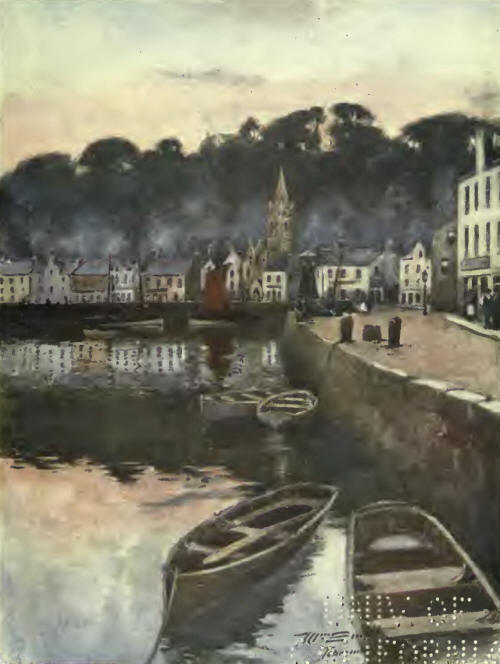
Where he, eager to please her and show her the beauties of the Highlands,
saw lovely white sands, and smiling plains of verdure, and far views of
the sunny sea, she only saw loneliness, and desolation, and a constant
threatening of death from the fierce Atlantic. Could anything have been
more beautiful? he said to himself—than this magnificent scene that lay
all around her, when they reached a far point on the western shore, in
face of them the wildly-rushing seas, coming thundering on to the rocks,
and springing so high into the air that the snow- white foam showed black
against the glare of the sky; the nearer islands gleaming with a touch of
brown on their sunward side, the Dutchman's Cap, with its long brim and
conical centre, and Lunga, also like a cap, but with a shorter brim and a
high peak in front becoming a trifle blue; then Coll and Tiree lying like
a pale stripe on the horizon; while far away the mountains of Rum and Skye
were faint and spectral in the haze of the sunlight. Then the wild Coast
around them, with its splendid masses of granite, and its spare grass a
brown-green in the warm sun, and its bays of silver sand, and its
sea-birds whiter than the white Clouds that came sailing over the blue. .
. And could anything have been more magical than the beauty of that
evening, after the storm had altogether died away.
The red sunset sank behind the dark olive-green of the hills a pale, clear
twilight took its place, and shone over those mystic ruins that were the
object of many a thought and many a pilgrimage in the far past and
forgotten years; and then the stars began to glimmer as the distant shores
and the sea grew dark; and then, still later on, a wonderful radiance rose
behind the low hills of Mull, and across the waters of the Sound came a
belt of quivering light as the white moon sailed slowly up into the sky.
Montalembert, in his Monks of the West, is very positive as to the
austerity of scenes that, beheld by a wave-tossed scholar, might well seem
the antipodes of La Belle France:
Nothing less attractive, on first approach, than this harsh and stern
scenery. Its picturesque is without charm, and its grandeur without grace.
One sadly traverses an archipelago of desert naked islets, like so many
extinct volcanoes, scattered upon a dull leaden sea, sometimes broken by
rapid currents and whirling gulfs. Except on rare days when the sun, that
pale sun of the north, comes Out to enliven these coasts, one's eye
wanders over a vast surface of brackish water, here and there streaked by
whitening wave crests, or by a foamy line of surf breaking now upon a long
reef, then against huge cliffs from which one hears afar the lugubrious
roar. Through the fogs and incessant rains of this rude climate, it is
hard to catch the summits of the mountain chains, whose steep, bare slopes
fall down into these cold waters, always kept astir by the shock of
contrary Currents and of the squalls that burst from the lakes and narrow
defiles inland.
Yet these Highland coasts, dull or forbidding as they may look from the
sea, warm into charmingness under loyal eyes like Norman Macleod's, that
can never forget the wild play-place of a happy boyhood:
A castled promontory, a range of dark precipices supporting the upland
pastures, and streaked with white waterfalls, which are lost in the copse
at their base, form a picture not very imposing compared with "what one
sees everywhere." A long ridge of hill rising some two thousand feet above
the sea, its brown sides, up to a certain height, chequered with green
stripes and patches of cultivation; brown heather-thatched cottages, with
white walls; here and there a mansion, whose chimneys are seen above the
trees which shelter it—these are the chief features along its seaboard of
many miles. But how different is the whole scene when one lands! New
beauties reveal themselves, and every object seems to change its size,
appearance, and relative position. A rocky wall of wondrous beauty, the
rampart of the old upraised beach which girdles Scotland, runs along the
shore; the natural wild wood of ash, oak, and birch, with the hazel copse,
clothes the lower hills and shelters the herds of wandering cattle; lonely
sequestered bays are everywhere scooped out into beautiful harbours;
points and promontories seem to grow out of the land, and huge dykes of
whinstone fashion to themselves the most picturesque outlines; clear
streams everywhere hasten on to the sea; small glens, perfect gems of
beauty, open up entrances into deep dark pools, hemmed in by steep banks
hanging with ivy, honeysuckle, rowan-trees, and ferns; while on the
hillsides scattered cottages, small farms, and shepherds' huts, the signs
of culture and industry, give life to the whole scene.
Perhaps few of us can rightly learn to love West Highland scenery who have
not in youth grown familiar with every blush of heather, every skin of
copse or bracken, every brown rib bared amid the turf; and all the moods
of those stern features under changing lights and shadows. One surpassing
glory of this region is the evening skies that may reward patient
sufferers under rain, for which see William Black's cruises, passirn. I
have travelled in four continents without elsewhere catching a more
brilliant glow of summer sunset than on the hills of Ardnamurchan or Appin,
where short winter days will sometimes die out in a rosy glory diffused
all round the horizon. Wailer Paton's Highland skyscapes were accused of
being too Turneresque in their gorgeous hues; but they make indeed no
exaggeration of what a Gaelic bard calls 'the tartan of the sky." The more
lovely for their uncertainty are the day-long or weeklong spells of fine
weather that may come in the heart of a stormy summer, sometimes lasting
for a month or two while the plains of the south seem to draw away the
freakish mountain clouds. Then in late autumn the west has often a truce
of halcyon days brooding peacefully over horizons where Italian blue,
touched with native softness, melts into a glassy sea among the openings
of richly tinted hills. And at all times the clearing after rain may
produce effects which a city poet aptly compares to the raising of the
curtain on a pantomime transformation scene.
More often the face of this region shows overcast, in too true keeping
with its gloomy traditions. The Christianity spread among these islanders
seems long to have been but skin deep, where every ruin is haunted by
memories of cruelty and hatred from days when the cross itself was dearest
as a fiery summons to bloodshed. Between Lismore and Mull rises the Lady's
Rock, on which Maclean of Duart let his wife, Argyll's daughter, be
exposed to the mercy of the tide, by one account for no worse crime than
that of being a Campbell ; but a more elaborately romantic version brings
in jealousy of a Spanish señora which urged this dame to procure the
historical blowing up of an Armada ship, whose guns were recovered in the
last century, and at our own day fresh attempts are on foot to dredge out
her long-buried treasures, as to which has been suggested the knotty legal
question whether they should not be the property of the king of Spain,
then at peace with Scotland. The lady's peril had a dramatic ending which
made this an oft-told tale : she was rescued by fishermen of her father's
clan, and when the husband came to Inveraray clad in hypocritical woe,
what seemed her ghost confronted him at the funeral feast that proved his
own.
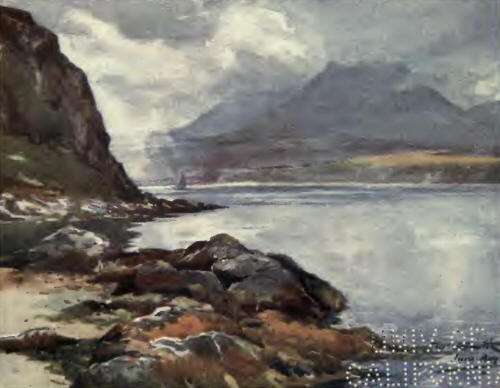
It was the Macleans of Mull who slaughtered their MacIan guests at the
wedding feast of their chief's daughter. On the same shore, Bloody Bay is
named from a fierce battle between father and son. On another side of the
island is shown the cliff over which a vindictively smarting clansman
leaped with the infant son of his chief, who had caused him to be
scourged.
On Eigg may be visited the cave where the whole population of Macdonalds
were suffocated by the Macleods of Skye, in revenge for their having set
some Lotharios of the latter clan adrift, bound and starving, in an open
boat. Another atrocity of the Macleods turned out less successful, when
they sought to burn a shipwrecked Macdonald crew in the barn that offered
false hospitality; but the intended victims got warning in time through
one of those love intrigues that so often laughed at hereditary feuds. Of
different castle dungeons the story is told how a prisoner here was fed on
salt beef, then left to agonising thirst, as many another captive has
starved to death, gnawing his own flesh in solitary despair. The annals of
more than one clan give it as exterminated in a day of slaughter, but for
posthumous sons borne by defenceless widows. Adamnan, the ninth abbot
after Columba, is credited with a humane law against women being exposed
to death in battle; but long after his time innocent children were not
spared by Highlander nor by Lowlander in the glut of vengeance. The
severance of creed at the Reformation seems to have whetted those
bloodthirsty lusts. The more famous massacre of Glencoe is outdone by one
of Covenanting times, when hundreds of Macdonald prisoners, Cavalier
partisans and "Amalekites," were in cold blood dashed from the rocks of
Cantyre by Presbyterian soldiers of Argyll.
Tradition, be thou mute! Oblivion, throw
Thy veil, in mercy, o'er the
records hung
Round strath and mountain, stamped by the ancient tongue
On rock and ruin darkening as we go—
Spots where a word,
ghost-like, survives to show
What crimes from hate or desperate love
have sprung
From honour misconceived, or fancied wrong,
What feuds,
not quenched, but fed by mutual woe.
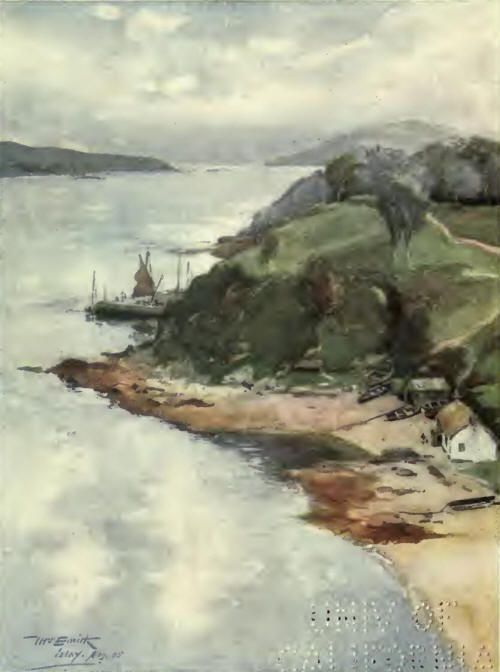
So Wordsworth was moved to exclaim in the Sound of Mull; and we may take
his example to pass quickly over a catalogue of sickening deeds that go to
show how, with all their unenlightened devotion, the far Highlands were
half heathen up till the time of the Jacobite risings. Then a vigorous
enforcement of law was accompanied by a movement of civilising
evangelisation, that put the people on a higher level both in Protestant
and in Catholic districts. In some parts the Catholic faith has never been
ousted. In some its adherents have vanished only by migration, as on the
island of Canna, with its conspicuous tower of a modern fane, erected as
memorial of a Catholic peer. In some cases the chief was able to lead over
or to lead back his people in a body, an easy process of conversion that
does not speak much for their principles. In the parish of the Small
Isles, Pennant heard of congregations "indifferently" attending the
services of priest or pastor, whichever happened to turn up. As a rule,
the two communions live more kindly together in the Highlands. than do the
Orangemen and Papists of Ireland. In certain nooks the Episcopalianism of
Stuart days still obstinately survives, where in many cases the first
Presbyterian preachers had a rough induction, as that one who, on his
presenting himself a second time at Kinlochewe, was stripped naked, tied
to a tree, and left to be tortured by midges ; or that Perthshire
presentee that could find no shelter but in the house of the charitable
divine whom he came to displace, who held his own for years after the
intruder had been marched, under escort of bagpipes and drawn swords, to
the bounds of the parish, and there dismissed unhurt only after taking an
oath never to return.
In most parts of the Highlands, however, the Kirk took its place with more
or less acceptation, the thinly-placed ministers helped by an inferior
order of "catechists" and by the schools promoted through a Christian
Knowledge Society. This church had the name of being on closer terms with
lairds, tacksmen, and factors than with the mass of its flock. About a
century ago began to pass over the Highlands waves of evangelical revival,
by which dissenting and other missionaries stirred the souls of an
excitable people. In the north especially great influence was exerted by
self-appointed censors of morals and doctrine called the "Men," of whom
the ministers themselves often stood in awe, and who, by their insistence
on the sternest aspects of a stern theology, preluded to that revolt
against "moderate" religion that came to a head in early Victorian days.
Since then the most active and most attractive body of faith in the
Highlands has been the Free Church of Scotland, whose ministers succeeded
to much of the loyalty lost by chiefs turned into unpopular land-lords. As
the Free Church was the austerer wing of the Old Kirk, so itself is lately
split into two branches, of which the more rigid has taken deeper root
among the mountains and islands where the old Calvinistic and Covenanting
views, banished from city pulpits, now find asylum. And when not even the
more liberal section of their own church seems pure in the sight of Gaelic
zealots, it might be expected that they would look on the Erastian
Establishment as Moabite and Philistine, albeit its nominal doctrines and
ritual are the same as their own. The struggle between these two has been
marked by an acrimony transferred from the former clan feuds, and in most
cases the Old Kirk went down like the Macdonalds before the Campbells.
Where means of grace are so hard to come by, the Free Church might be
thought to do well in garrisoning some neglected end of huge,
wave-sundered parishes but often it has chosen rather to gather its
congregations beside the emptied parish church. In Iona, for instance,
with its two or three hundred inhabitants, there rose both an Established
and a Free Church in the face of the Cathedral, whose long-deserted stones
silently preached such a moving sermon for hearts open to the still, sad
music of humanity."
The communion, now so powerful in the Highlands, is accused by its enemies
of provoking more to "sound" faith than to good works, but it appears to
have raised the moral character of the clergy, perhaps at the expense of
their culture, while it too indiscriminately sets its face against the
joys of life fostered by divines like Norman Macleod's forebears. The Free
Church has done its best to frown down not only bogeys and fairies, but
the bagpipes, fiddling, dancing, and other alleviations of a hard lot, on
which is imposed the burden of the Mosaic or Babylonian Sabbath, so
patiently taken up by Scotsmen in exchange for the penances of the monkish
dispensation. The Catholic priests are more tolerant: in at least one
island the bagpipe summons the people to mass; but the orthodox Calvinist
frowns at music unless the pseudo-Biblical strains of the Jew's harp,
which, under the name of the trump, has long been popular in the
Highlands. Here lingers the prejudice against instrumental music in
church, not so long ago strong over all Scotland, as was the childish
objection to hymns, even scriptural paraphrases, or any sacred songs but
those believed to be written by David. Thus the prevalent theology has
become accomplice with hard times and sad surroundings in deepening the
cloud that lies over Highlands and Islands.
